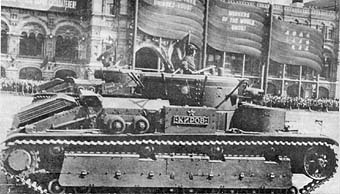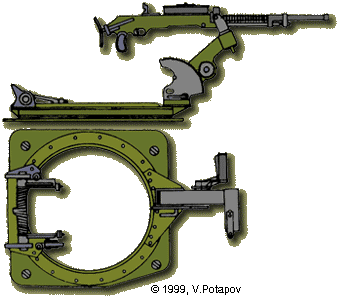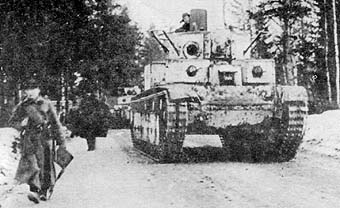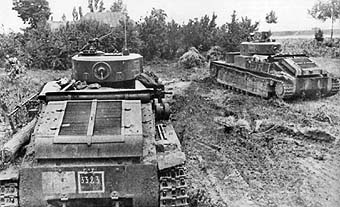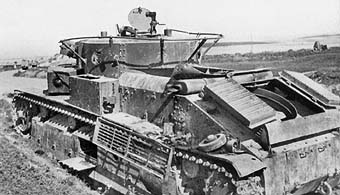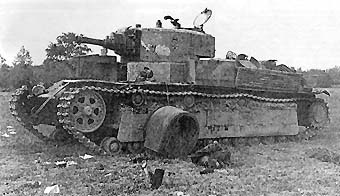| Language |
|---|
| Google Translation |
|---|
|
|
| Main Resources | |||||||||
|---|---|---|---|---|---|---|---|---|---|
|
| Additional Stuff | ||||
|---|---|---|---|---|
|
| Online Services | ||
|---|---|---|
|
| Miscellaneous | |||||||
|---|---|---|---|---|---|---|---|
|
| Private messages |
|---|
|
You are not logged in. |
| Log in |
|---|
| Users online |
|---|
| We have 12 guests online |
| Search |
|---|

| T-28: Development History and Combat Employment |

|

|
| Medium Tanks | ||||||
T-28 Medium Tank Development History
Before the Great Patriotic War, the T-28 multi-turret medium tank was a symbol of the Red Army as was his heavier "brother," the T-35. It's silhouette is well known from pre-war newsreels about Soviet military parades on Red Square (Moscow). In 1931 a new project was undertaken to build a three-turret medium tank. It was designed by a group from OKMO ("Opytnij Konstruktorsko-Mekhanicheskij Otdel" - Experimental Design Department) of the "Bolshevik" machine-building plant in Leningrad. The group was led by Chief-Engineer N.V.Barykov and Chief Engineer N.V.Tzeitz. At the end of 1931 the first prototype was sent to the proving grounds for testing.  T-28 Medium Tank. (A.Balakin)
The main turret of the new tank was armed with a 45 mm gun and a DT machine-gun. Two other turrets were armed with DT machine-guns only. The main turret was rotated by an electric drive which was a novelty for that time. Initial tests showed many shortcomings in the chassis as well as in the transmission. In 1932, the tank-building workshops of the "Bolshevik" Factory were segregated into an independent facility, factory #174. Due to full utilization of this factory for manufacturing T-26 light tanks the manufacturing the T-28 tanks was assigned to the "Krasnij Putilovetz" industrial plant (since 1934 - "Kirovskiy Zavod"). All documents for T-28 production were sent to that plant in November 1932. To maintain mass production of a new tank, a special group of engineers was summoned. Later this group was reorganized in Special design bureau #2 (or simply SKB-2) with director O.M.Ivanov, Chief Engineer N.F.Komarchev (in 1933 he was arrested and replaced with A.G.Efimov). In May 1937 O.M.Ivanov was also arrested and replaced with J.Y.Kotin. By February 25, 1933, the first 8 armored hulls had been produced and assembling of the first 4 tanks began. By 1 May, 12 vehicles were completed, 10 of which took part in a military parade in Moscow and the other two - in Leningrad. On 11 August 1933 the new medium tank was accepted to the Red Army service under the T-28 designation. The first order from the Red Army to produce the T-28 (in 1933) was for 90 T-28's. However, up to end of the year the industry could build only 41 new vehicles. A total of 503 tanks were built during mass production runs. 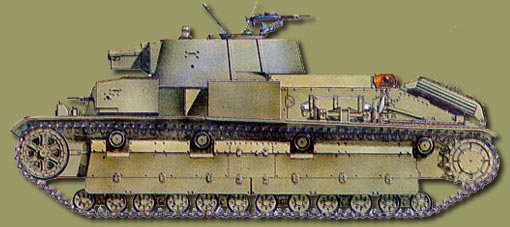 Т-28 в стандартном летнем камуфляже 1940-1941. (рис. А.Балакина) Production T-28's were significantly distinguished from the prototype. The main difference was in the hull: production vehicles had a welded hull instead of riveted. The main turret was modified as well and rearmed with a short barreled 76.2 mm gun KT-28 (the original name of that gun was KT, the index "28" meant it was modified to be installed in T-28) instead a 45 mm gun. The chassis and transmission were also slightly improved. In general, the T-28 had several versions. The most "improved" was the second series - it had over 600 modifications. 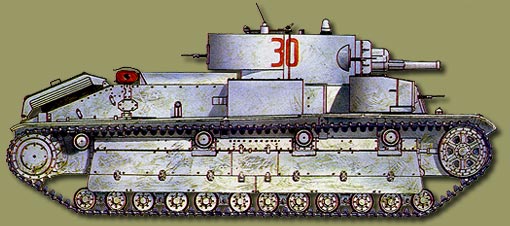 T-28 with a standard summer camouflage 1940-1941. (A.Balakin) At the time, there were only three major modifications of vehicle: - From 1938 the tank was re-armed with a 76.2 mm L-10 gun;
It should be noted that during mass production the T-28 achieved a high commonality with the T-35 heavy tank. For example, both vehicles had the same main turret (cylindrical and conic versions). Also, the smaller turrets (armed with TMG's) were the same. At first the T-28 was armed with a 76.2 mm short-barreled tank gun: KT-28. Later versions received a more powerful tank gun L-10 with a barrel length of 26 calibers and muzzle velocity of 555 m/s. In fact, there were a very limited number of L-10 guns, and some tanks were still armed with KT. Both small turrets were armed with DT machine-guns. Each small turret could rotate 165°. The last version was equipped with an AA P-40 machine-gun ring armed with 7.62 mm DT AAMG. In general, the T-28 had quite a modern design for that time. However, at the same time, the tank had some serious shortcomings, especially in the engine and transmission. Despite the designers' efforts these defects persisted. These difficulties were the result of immature technology processes as well as the Red Army's lack of experience in maintaining such complex vehicles. Nevertheless, in the 1930's the T-28 was the most powerful medium tank in the world. The increasing firepower of anti-tank weapons (especially antitank guns) demanded increased armor protection and increased speed; that's why the multi-turret versions became obsolete.  Combat Employment
The first 10 tanks were sent to the 2nd Independent Regiment of RGK of the Leningradsky military district. In fact, independent tank units of RGK were represented since 1924. The 2nd Independent Regiment was formed in 1929. Later, due to production of new T-28 tanks another four tank regiments of RGK were formed: in Smolensk, in Kiev, in Kharkov, and in Slutzk. Organization of these regiments was changed several times. By the end of 1935, each regiment consisted of three battalions of 30 tanks (T-28 and T-35) per battalion. In December 1935 these regiments were collected into independent heavy tank brigades. In these brigades, tanks of different classes weren't mixed with each other. In other words, a brigade might have T-28's or T-35's but not both types at the same time. A heavy tank brigade of T-28's consisted of a three common tank battalions, a training battalion, supply battalion and some other units. This organization was created on 12 December 1935 by the order of Minister of Defense. However on 21 May 1936 all these brigades were assigned to the RGK. In 1939 there were four heavy tank brigades: the 4th, 5th 10th, and 20th tank brigades. In a deviation from the policy of matching tank types to units, the 5th tank brigade had both T-28 and T-35. The 4th and 10th tank brigades were the first tank brigades which took part in military conflict. In September 1939 they took part in the occupation of Bessarabia (West Ukraine). After analysis of the first deployment of these brigades, ABTU ordered the reorganization of all tank brigades: now they were to consist of three tank battalions of 156 tanks per battalion (117 T-28 and 39 BT). There were also future plans to replace them with the KV-1. On 30 November 1939 the Russo-Finnish war began (also known as the Winter War). The 10th and 20th tank brigades took part in this war. When the war ended, the 20th Brigade (commander - kombrig Borzilov) was awarded with the Red Banner Order. During the Winter War, T-28 tanks were used first for direct gunfire on embrasures of a Finnish pillboxes. However the standard 30 mm armor couldn't protect the tanks from Finnish AT-guns. That's why Soviet losses of T-28's were so high. Immediately after those battles, the T-28's were equipped with additional armor. During the Winter War a couple of T-28 tanks were captured by the Finns. In 1941 they've captured another five vehicles. Those ex-Soviet tanks served up to the end of the war in the one Finnish tank brigade. In 1944 one of those vehicles was modified (all turrets removed) and used as an armored evacuation vehicle up to 1951. There are rumors, that in 1955 two tanks were sold to Turkey. However, not one archival document confirm that. In March 1940, the Red Army started its new reorganization and formed several mechanized corps. Each mechanized corps consisted of two tank divisions and one motorised regiment. In that time all tank brigades were disbanded and their tanks were added to the new tank divisions. For example, on 22 June 1941, the 8th Tank Division (4th Mechanized Corps) had 75 T-28 tanks, another 5 vehicles were in 10th Tank Division (15th Mechanized Corps). Both corps were attached to the Kiev military district. On 15 July 1941, the 16th Mechanized Corps received an order from the commander of South-West Front to make a strike on Zhitomir. The 29th Tank Regiment (15th Tank Division) took part in this battle. During a counter-attack at Semenovka (a village near Berdichev) one platoon of T-28's under the command of 1st Lieutenant Vasiliy Sumtzov destroyed three German tanks, two AT-guns, one mortar, 7 trucks and about 100 German soldiers. The fate of T-28 tanks was the same as for all other Soviet tanks - most them were lost in first two months of war. Some of the surviving T-28's served up to 1943 on the Leningradskiy Front and during the Moscow counter-offensive (1941). In the summer of 1941 the design of the T-28 became obsolete due to the drawbacks of multi-turret vehicles. German Pz-III and Pz-IV had an equal armor protection but were much more maneuverable, but the T-28 was better armed than any German tank in 1941 and could hit any German tank from long distances. Experimental tanks had mine-clearing equipment TM-35 or equipment for crossing rivers under water T-28PKh.  Manufacturing Armoring Scheme 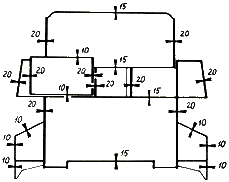
|
||||||
Discuss this item on the forums. (0 posts)
|
© The Russian Battlefield, 1998 Webdesign: |




